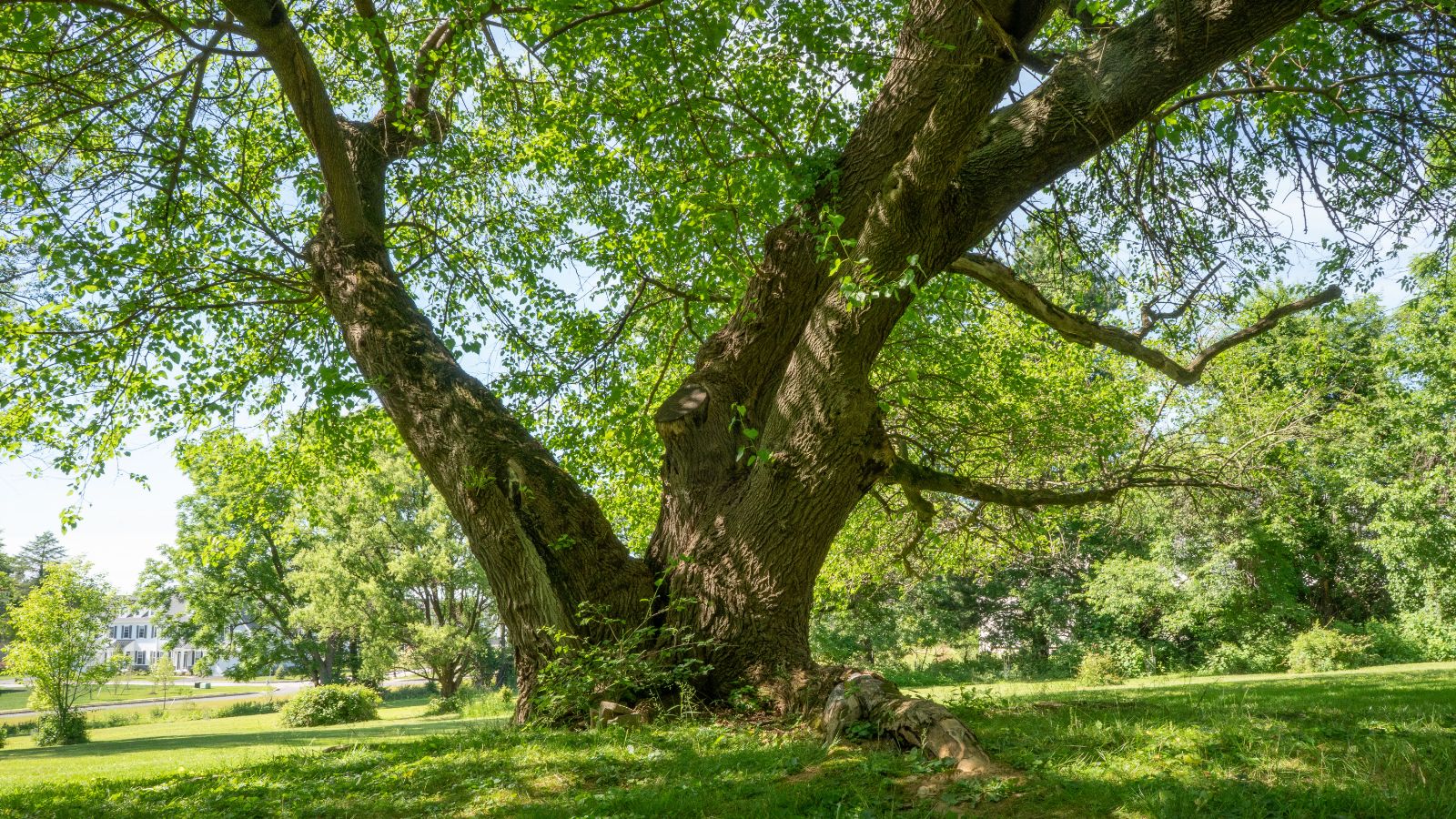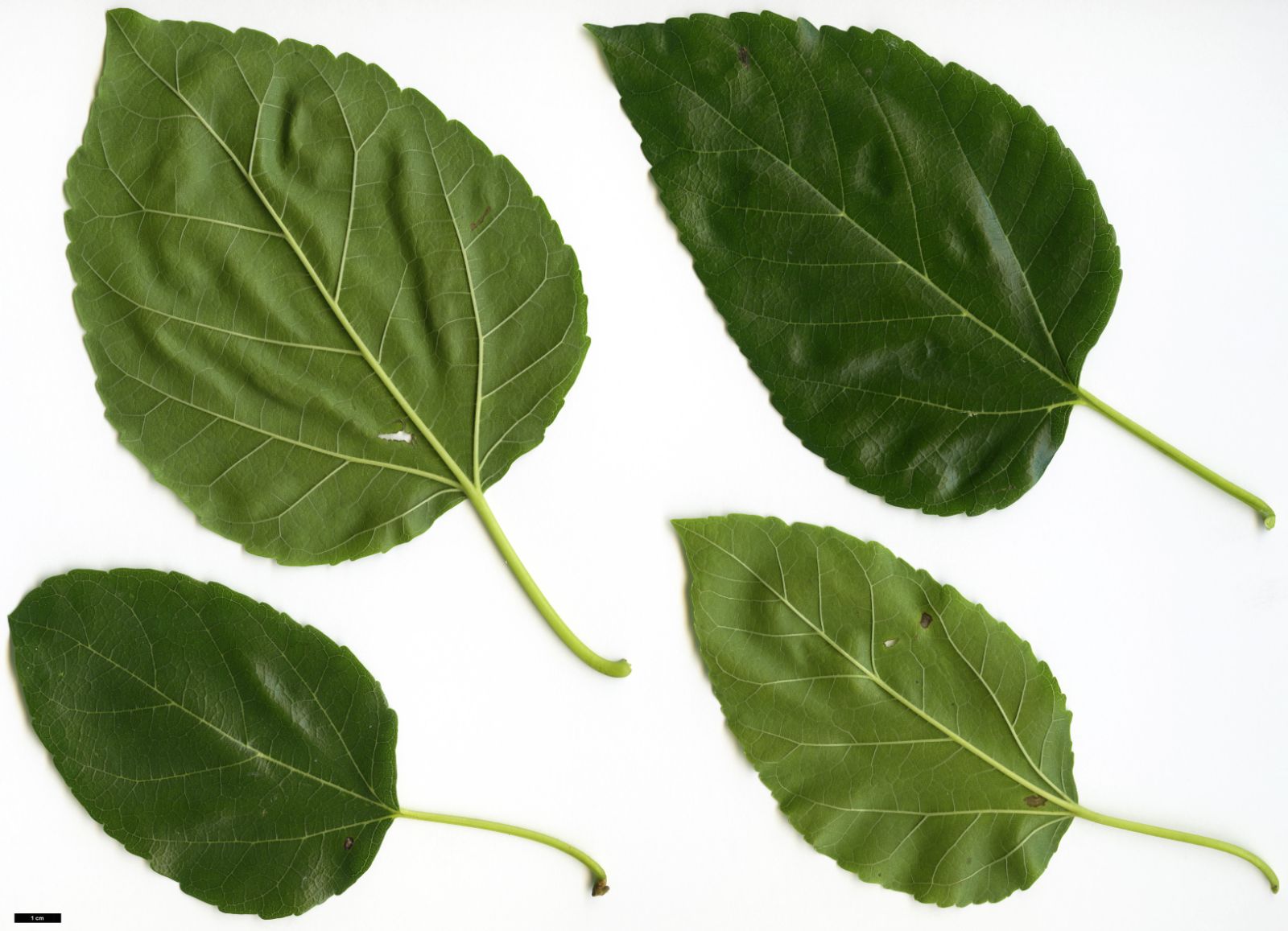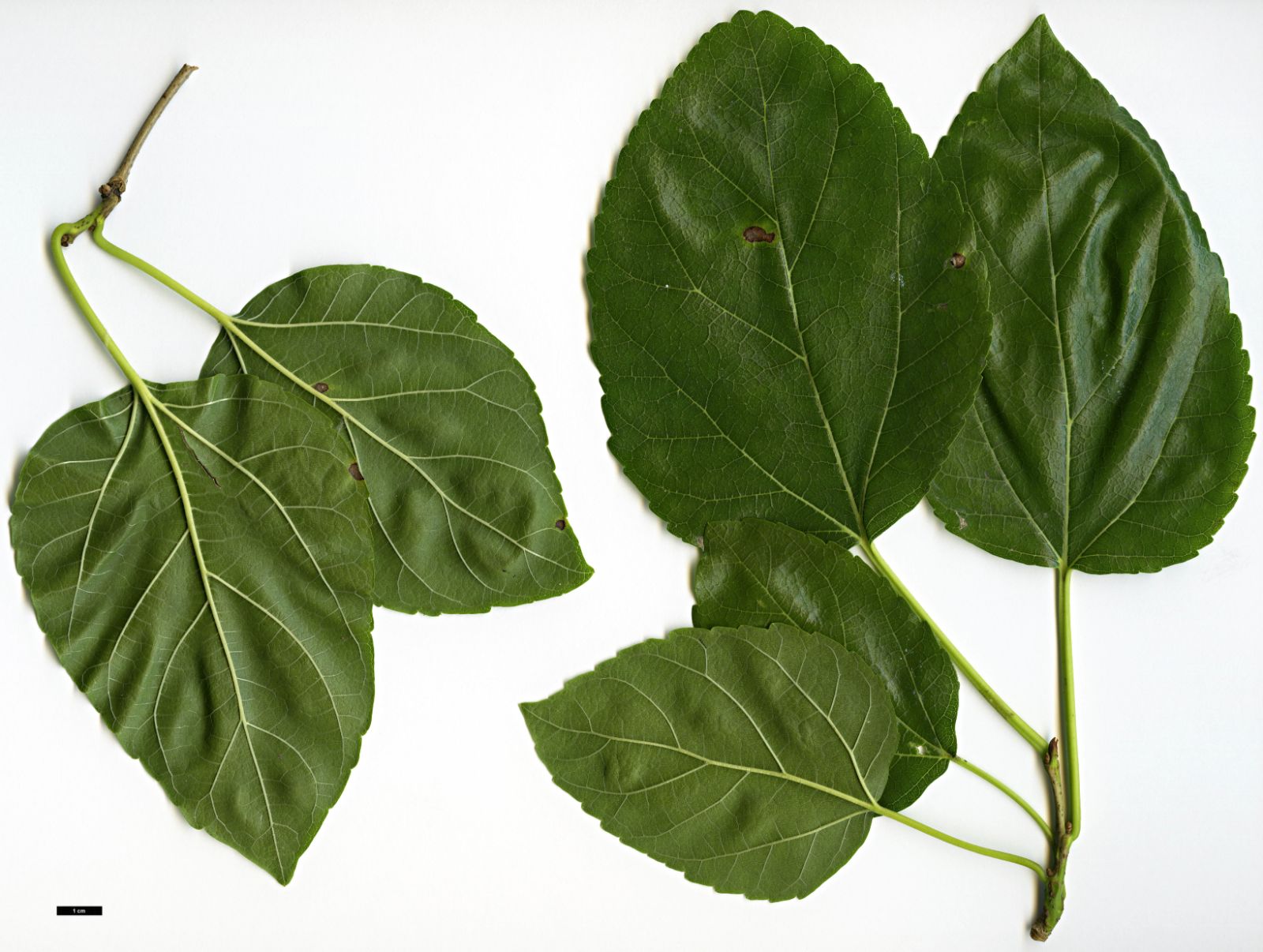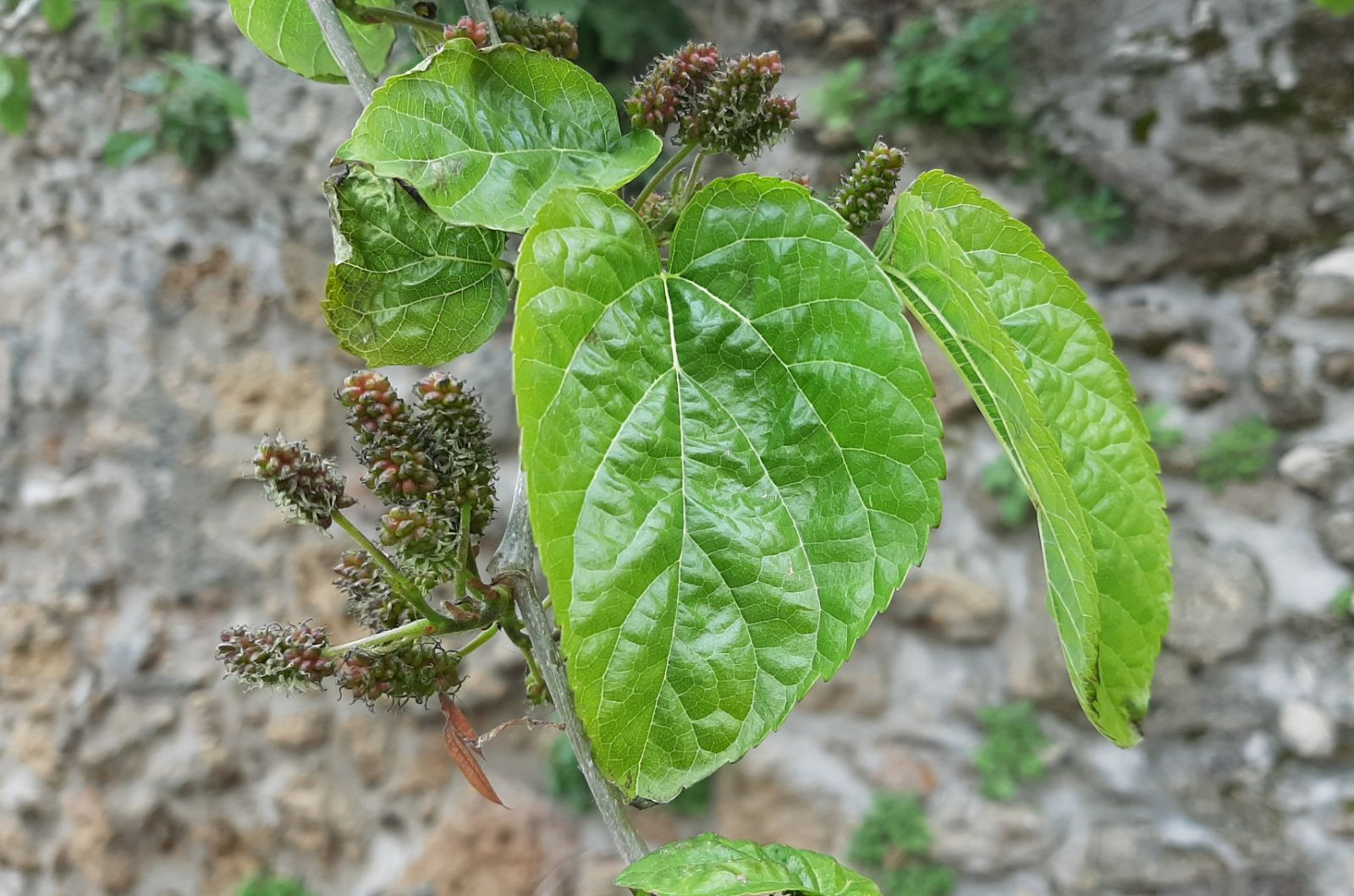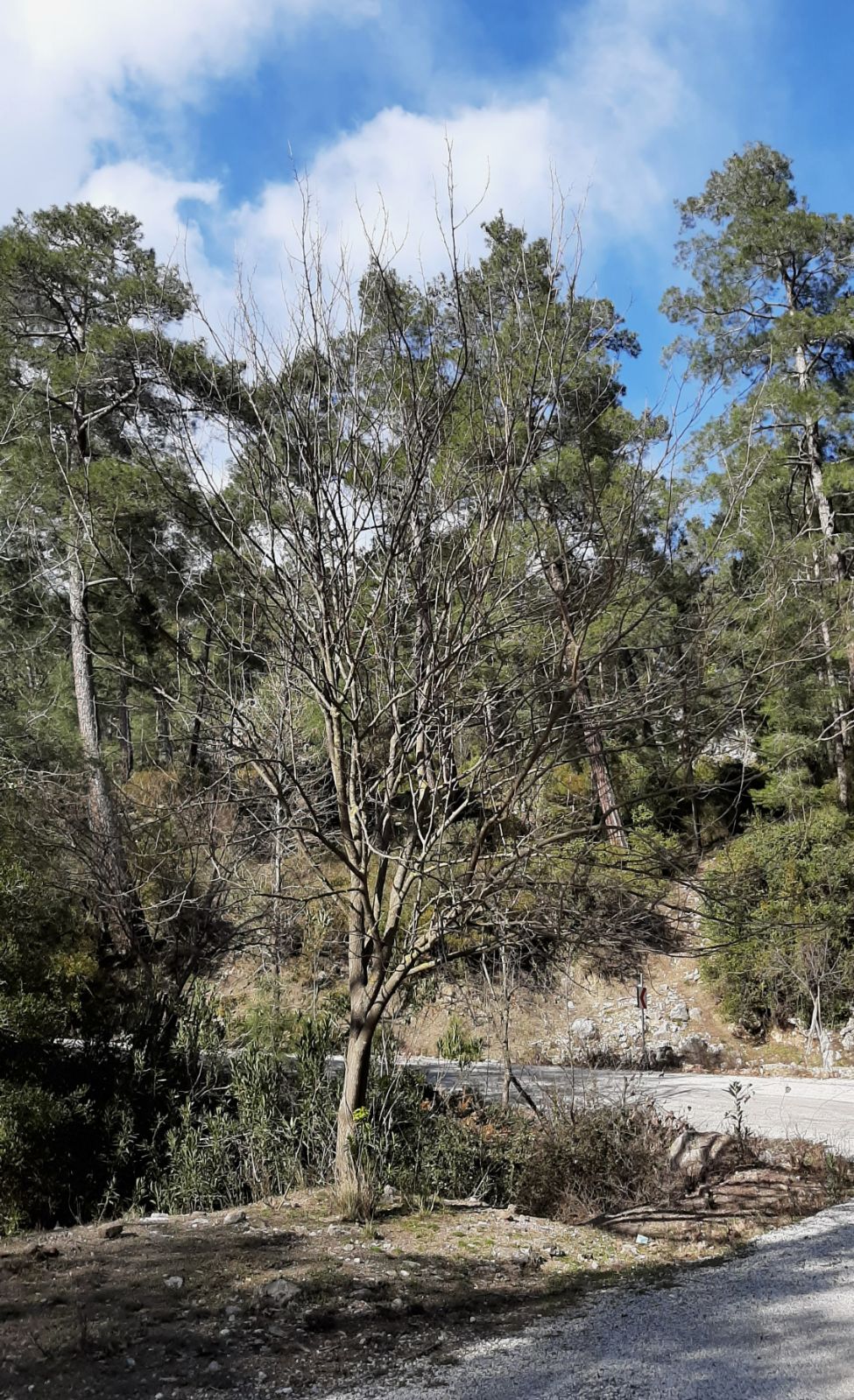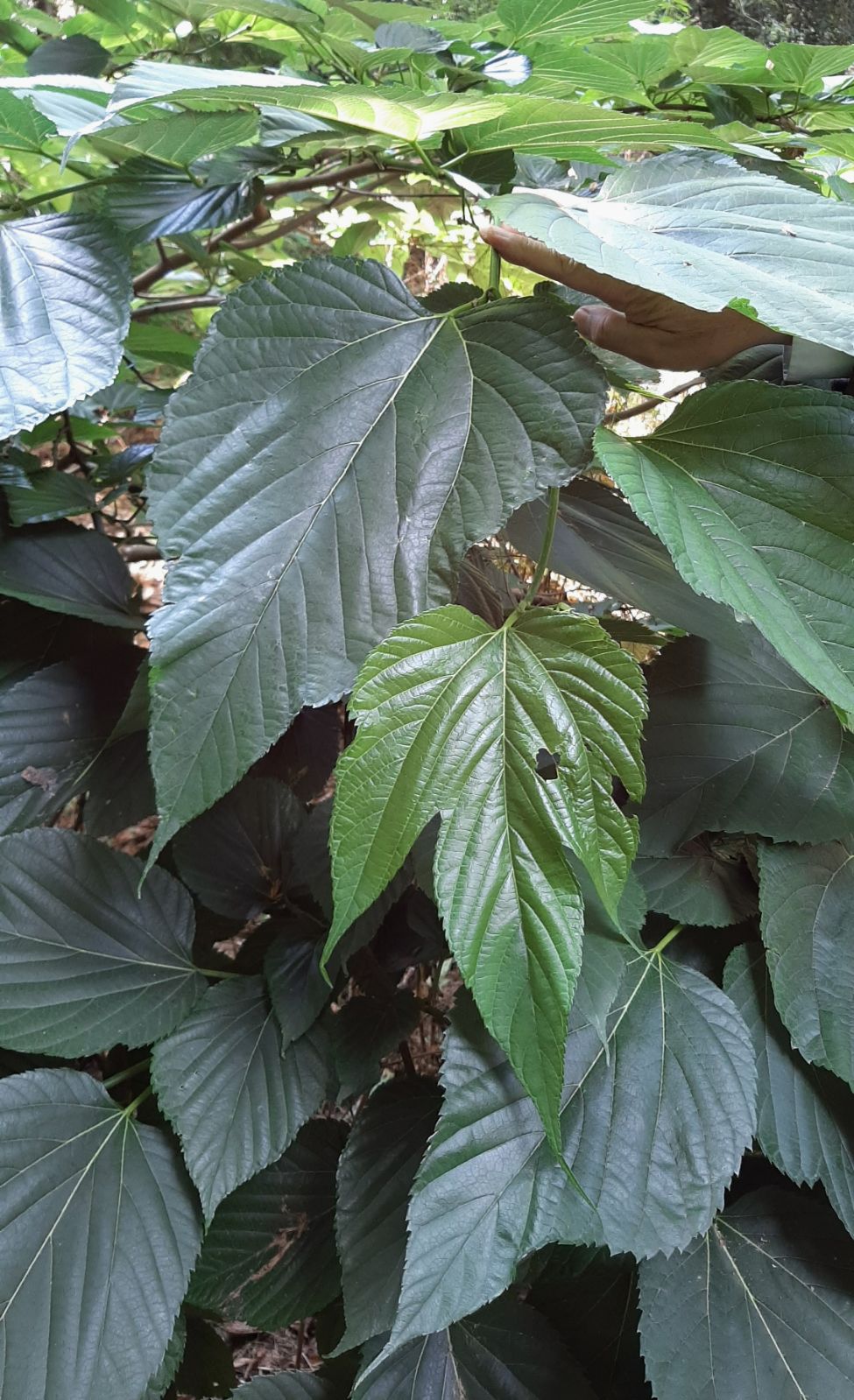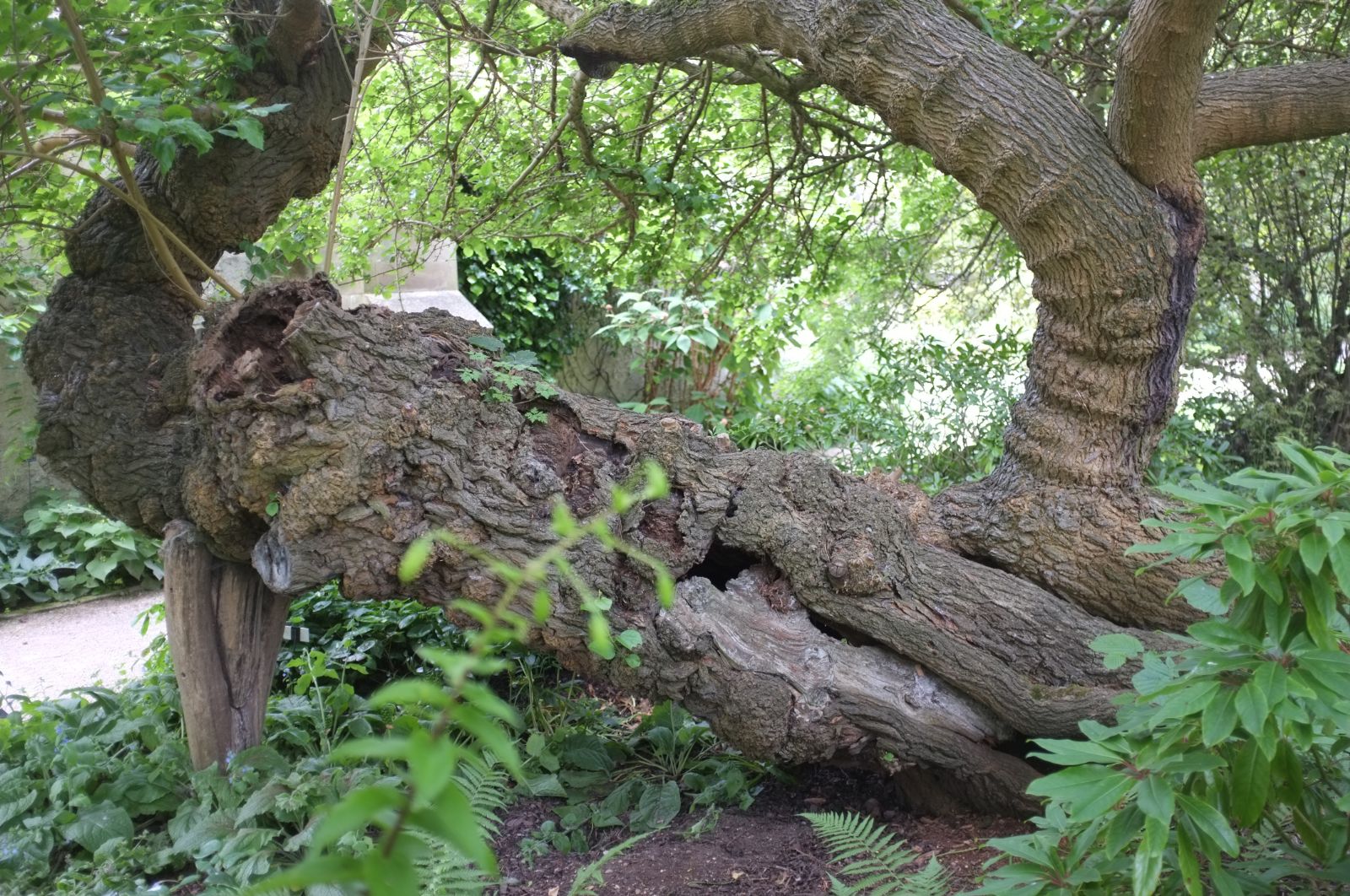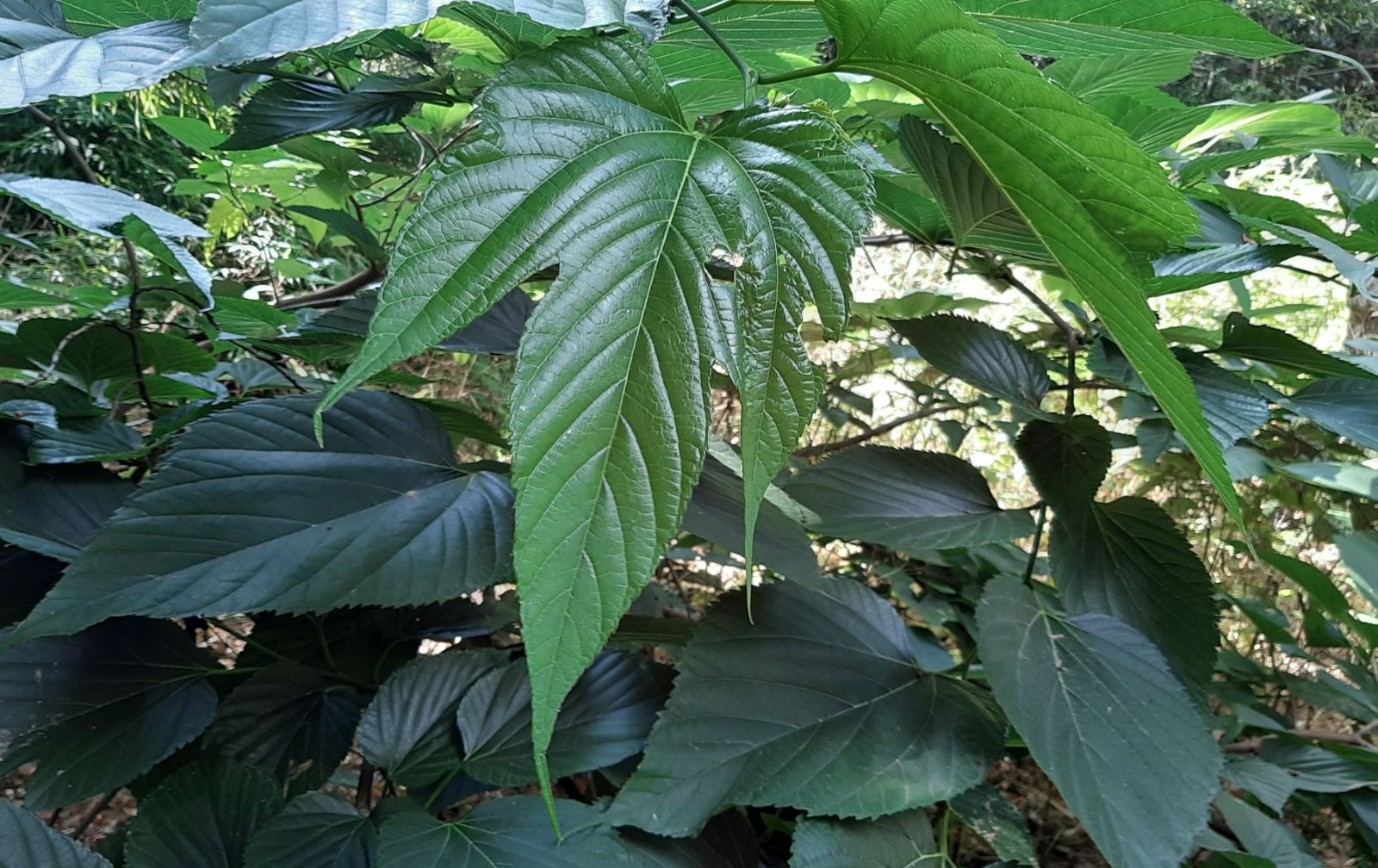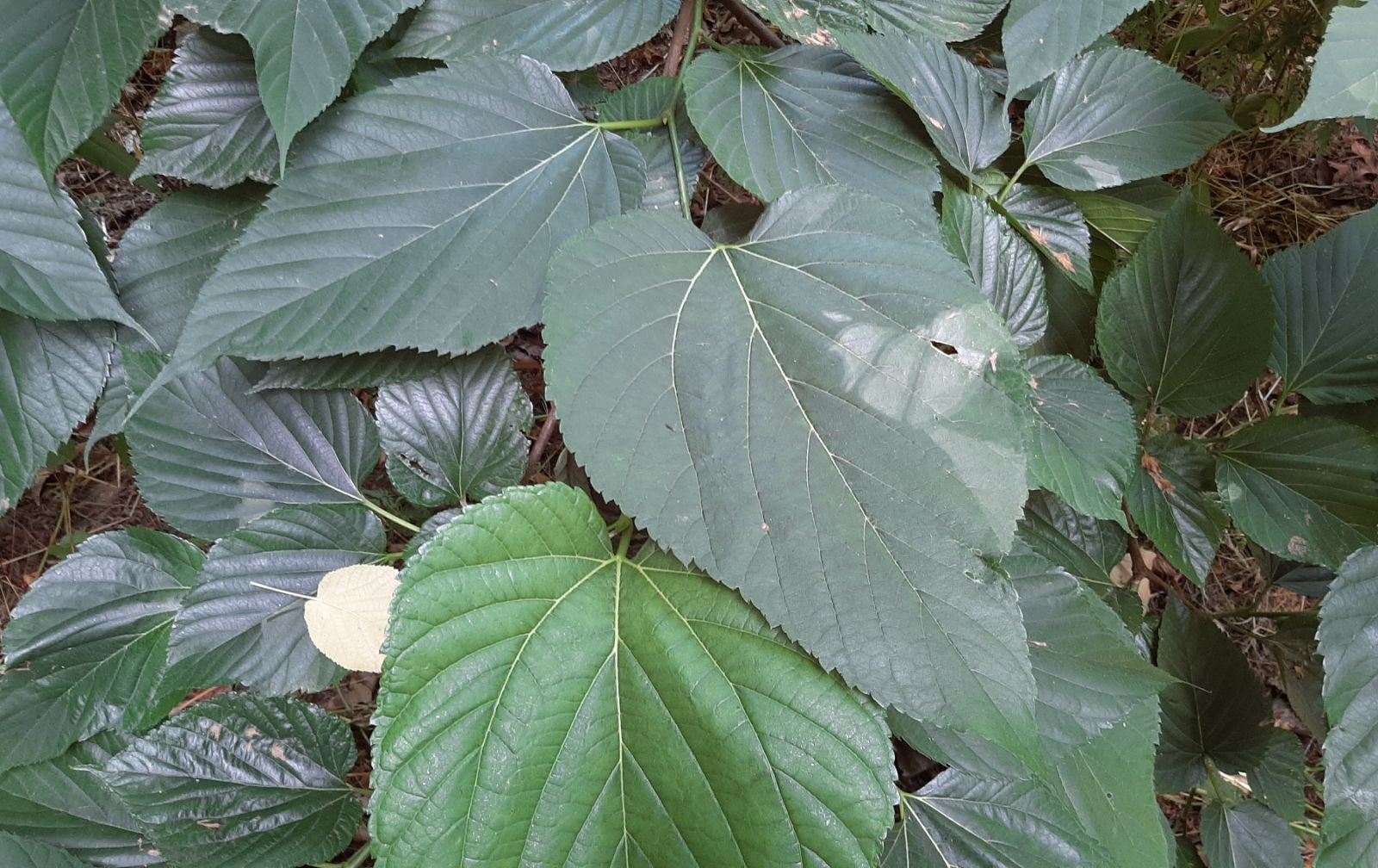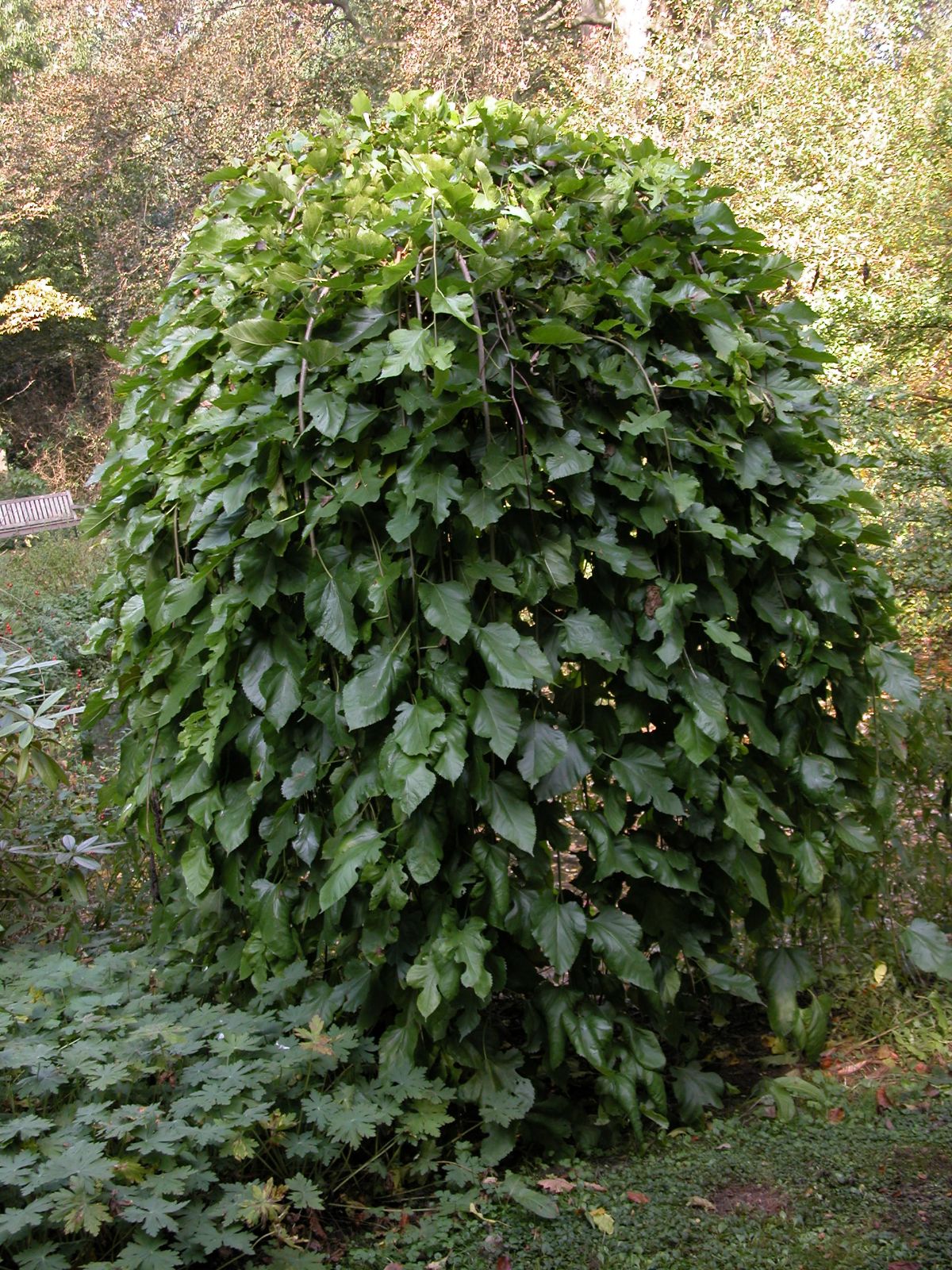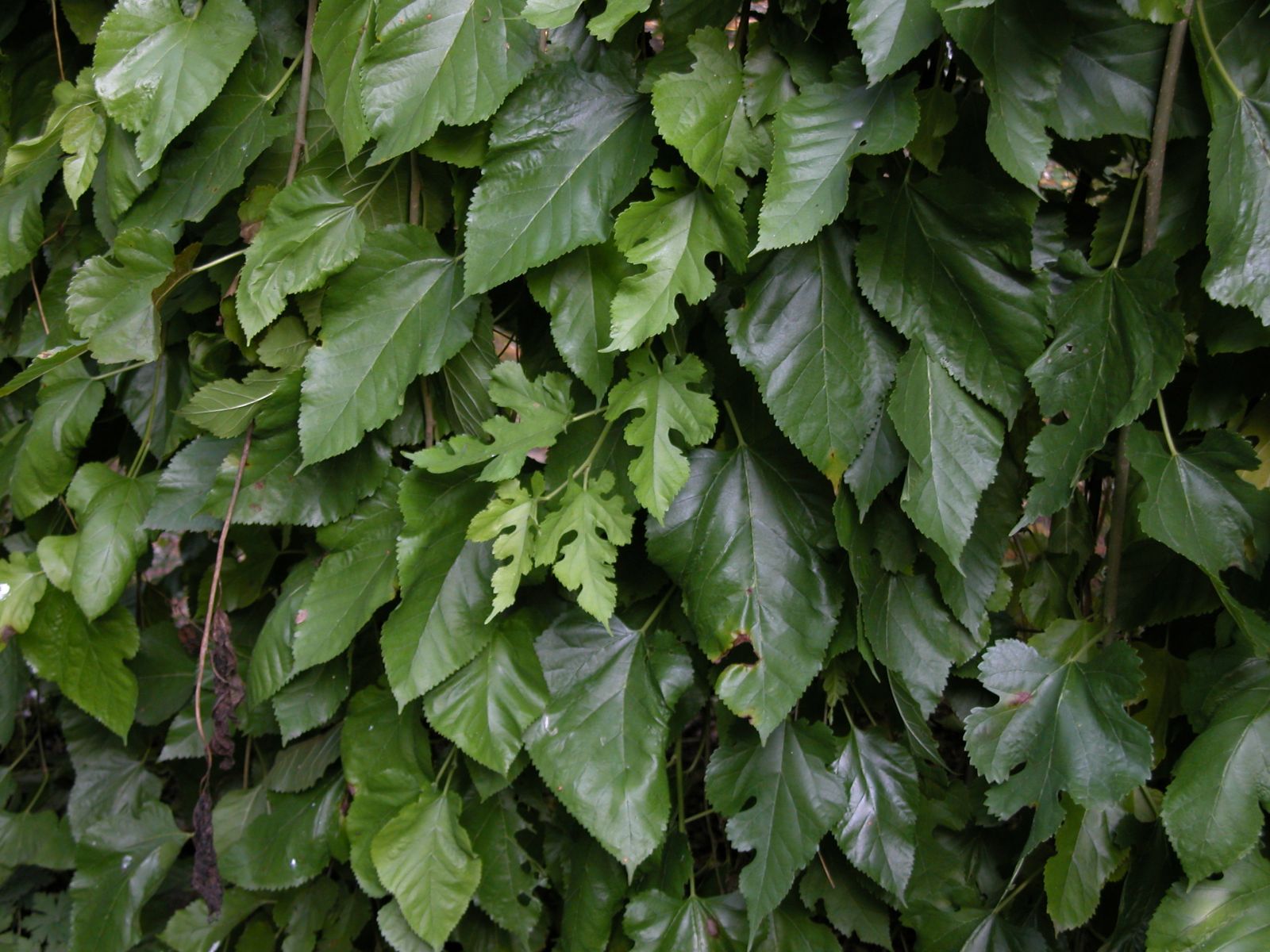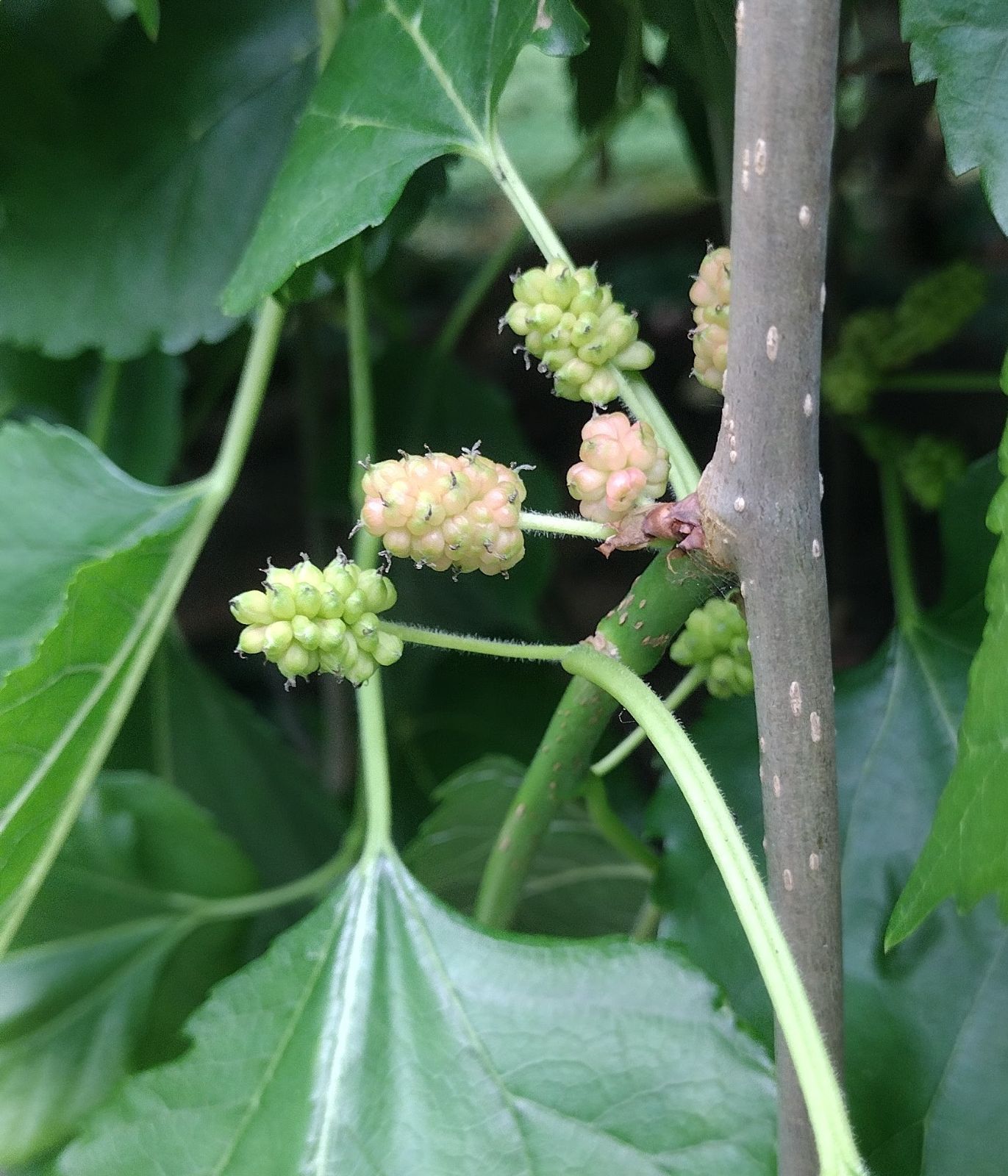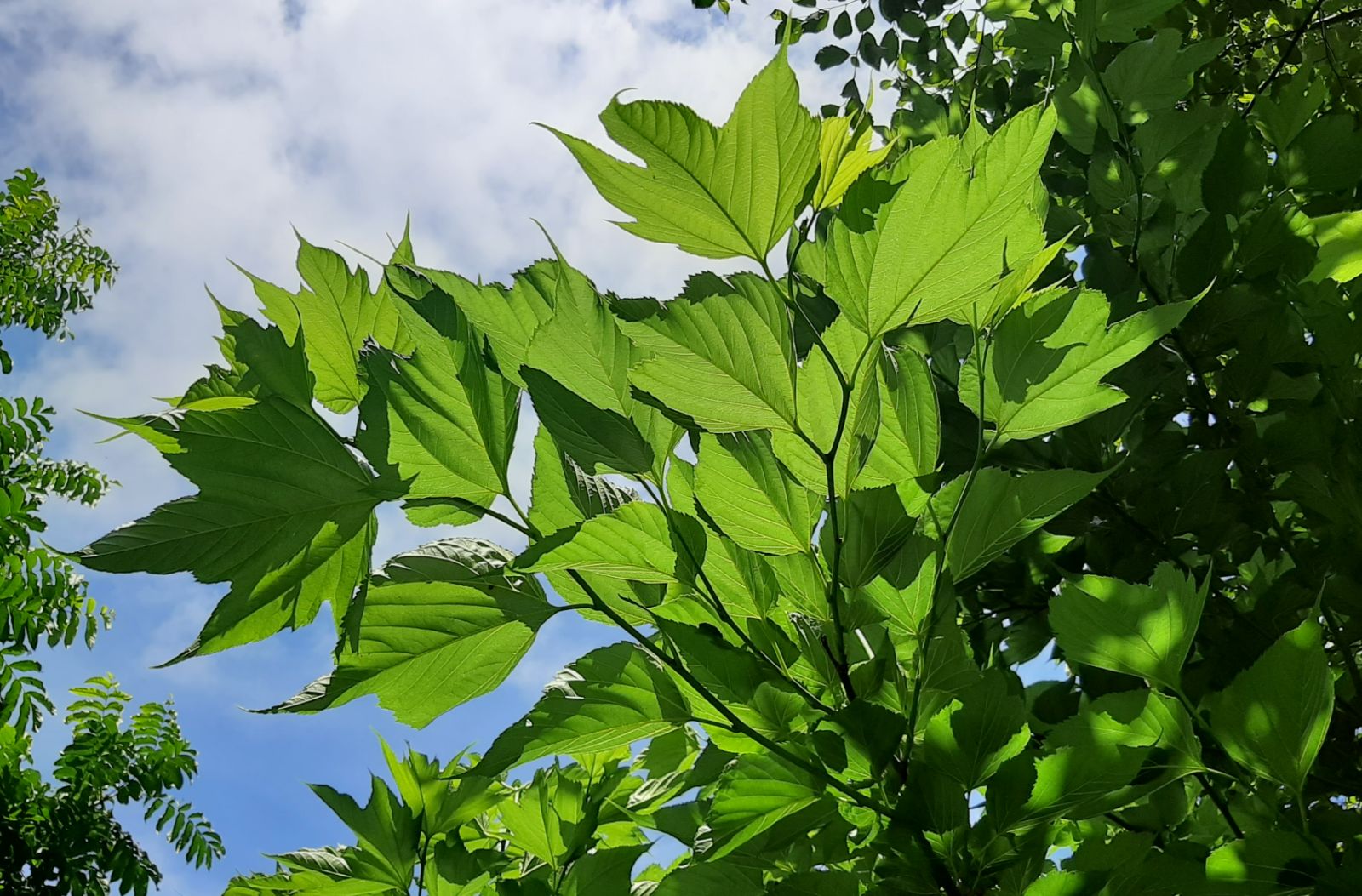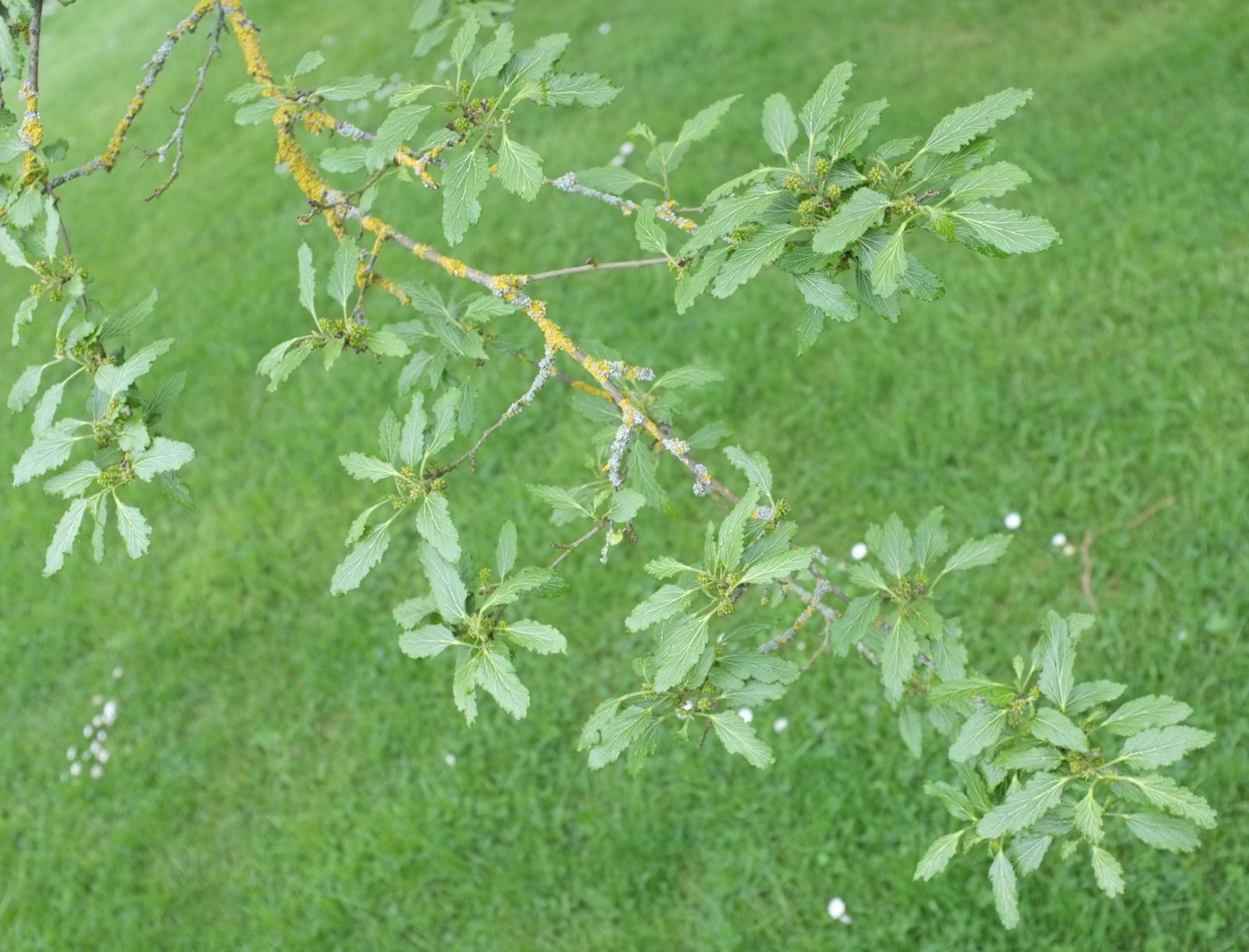Morus alba
Sponsor
Kindly sponsored by a member of the International Dendrology Society.
Credits
Tom Christian & Peter Coles (2022)
Recommended citation
Christian, T. & Coles, P. (2022), 'Morus alba' from the website Trees and Shrubs Online (treesandshrubsonline.
Genus
Common Names
- White Mulberry
- 桑 (sang)
- Gelso Bianco
- Mûrier Blanc
- Mûrier Commun
- Weiße Maulbeere
- Witte Moerbei
Synonyms
- Morus alpina Raf.
- Morus arabica (Bureau) Koidz.
- Morus byzantina Sieber ex Steud.
- Morus constantinopolitana Poir.
- Morus hispanica Loudon
- Morus tatarica L.
Infraspecifics
- 'Alpine'
- 'Arizona Fruitless'
- 'Aurea'
- 'Beautiful Day'
- 'California Giant'
- 'Champaign'
- 'Chaparral'
- 'Damas'
- 'Downing's Everbearing'
- 'Fan San'
- 'Fegyvernekiana'
- 'Fruitless'
- 'Greenwave'
- 'Hampton'
- 'Ho-o'
- 'Holicong Weeping'
- 'Integrifolia'
- 'Issai'
- 'Itagawa'
- 'Italica'
- 'Kingman'
- 'La Grosse Reine'
- 'La Reine Bastarde'
- 'Laciniata'
- 'Macrophylla'
- 'Morettiana'
- 'Multicaulis'
- 'Nana'
- 'Paper Dolls'
- 'Pendula'
- 'Platanifolia'
- 'Pyramidalis'
- 'Rosea'
- 'Snowflake Lobed'
- 'Stribling'
- 'Tehama'
- 'Urbana'
- 'Venosa'
- 'Wellington'
- 'White Berry'
- 'Widman Mitchell'
Trees or large shrubs 3–12 m tall; dioecious, rarely monoecious. Bark grey, shallowly furrowed. Branchlets pubescent. Winter buds reddish brown, ovoid, finely pubescent, 1–4 mm. Stipules lanceolate, 2–3.5 cm, densely short-pubescent. Leaves ovate to broadly ovate, irregularly lobed (young shoots) to ± entire (old shoots), 5–30 × 5–12 cm; upper surface bright green, glabrous, glossy; lower surface sparsely pubescent along midvein with occaional tufts in vein axils; base rounded to cordate, margin coarsely serrate to crenate; apex acute, acuminate, or obtuse; petiole densely pubescent, 0.5–5 cm. Male inflorescences 1–7 per node, pendulous, 2–3.5 cm, densely covered with white hairs; peduncle 0.5–2 cm; male flowers with green, broad-elliptic calyx lobes. Female inflorescences 1–5 per node, 1–2 cm, pubescent; peduncle 0.5–1(–3?) cm, pubescent; female flowers with ovoid calyx lobes with marginal hairs; ovary ovoid; style absent; stigmas branched, papillose. Syncarp red at first, maturing dark purple to black, purple, or greenish white, ovoid, ellipsoid, or cylindric, 1–2.5 cm. Flowering spring, fruiting spring to summer; fruits white, pink, red, purple, or black. (Wu, Zhou & Gilbert 2003; Razdan & Dennis Thomas 2021).
Distribution China Thought to originate from central and northern China, it has been widely cultivated throughout temperate Asia for millennia. In more recent times it has been introduced to, and naturlised in, many parts of the Americas, Europe, and Africa
Taxonomic note Plants of the World Online (Plants of the World Online 2022), whose taxonomy and nomenclature is followed in this account of Morus, lists 41 synonyms for M. alba. Many of these are now considered cultivars, for example M. multicaulis (Perr.) Perr. is a synonym of M. alba ‘Multicaulis’. Rather than list such synonyms under the species, we list them under the individual cultivars to which they pertain. Other frequently seen synonyms are listed above in the usual way.
Native to central and northern China, and possibly adjacent regions of temperate Asia, Morus alba has been cultivated from at least 2700 BC in northwest China and from the early 15th century in Mediterranean Europe – possibly earlier in the Balkans, and probably earlier still in central Asia and the near East. White Mulberry is the tree on which the domesticated silkworm (Bombyx mori) is fed, exploiting a natural symbiosis of the species with the wild silk moth (Bombyx mandarina). As a result of the spread of sericulture White Mulberry is now found on every continent of the globe except Antarctica. This long history of cultivation, especially in the west, has doubtless contributed to the confusing profusion of named cultivars, whereby, as Loudon put it: ‘the same kinds are even distinguished in different countries by different names’ (Loudon 1838). The plethora of cultivars not withstanding, it is worth taking a moment to obliterate an oft-quoted falsehood, that White Mulberry has white fruits. A few clones do indeed have white or pale pink fruits, but it is much more common for the fruits to mature through shades of red and purple as in other mulberry species. The easiest way to distinguish White Mulberry from the other commonly grown species (Black and Red Mulberries) is that the upper surface of the leaf is smooth to the touch, but distinctly scabrous in Black and Red Mulberry.
Another consequence of millennia of cultivation is that White Mulberry rarely occurs anywhere in its wild state today, although small relic populations have been found on alluvial river plains in Kazakhstan and alongside other wild fruit trees in gallery forests of the Western Tien Shan, Kyrgyz Alatau and Karatau mountains (Sitpayeva et al. 2020) as well as in isolated mountainous regions of Japan, and a few Japanese archipelagos such as the Ogasawara (Bonin) Islands and Izu Islands, where specimens over 1000 years old have been recorded (Coles 2019).
While early sericulture west of the Caspian Sea was initially based on the Black Mulberry (M. nigra) – generally assumed to be indigenous somewhere in this broad region – this was gradually superseded by introduced White Mulberry, which coppices more readily and is more resilient to regular harvesting of its leaves. M. alba first appeared in continental Europe around 1410, in Mondovi, Piedmont (Italy) and by 1434 was recorded in Pescia, Tuscany (Zanier 2019). Over the next century M. alba came to be cultivated on a massive scale throughout the Italian peninsula, under the effects of mercantile competition between wealthy landowners, diverse incentive schemes, and legal obligations.
Archaeobotanical analyses suggest that the White Mulberry also arrived in Corsica in the early 15th century (Durand et al. 2016). As in Italy, White Mulberry gradually replaced the Black for sericulture throughout mainland France – notably in the Comtat Venaisan around Avignon, in the Languedoc region and the Loire valley. A similar picture emerged in Spain, where White Mulberry came to dominate moriculture (growing mulberries to raise silkworms). In the first decade of the 16th century, until his assassination in 1610, the French King Henri IV promoted large-scale planting of White Mulberries for sericulture, overseen by the agronomist Olivier de Serres. Some 10,000 trees were planted in the Tuileries Gardens in Paris and in the grounds of royal castles near the capital. None of these original trees is thought to survive today (Coles 2019).
White Mulberry succeeds quite well in the south of England, where it was probably first introduced in the late 16th century – Gerard describes it in the 1597 edition of his Herbal (Gerard 1597). In an attempt to rival the successful silk industries in warmer countries around the Mediterranean, the newly installed Stuart King, James VI & I, requested landowners to plant mulberries via a 1607 circular letter to his Lords Lieutenant. Tens of thousands of White Mulberry saplings were imported from Languedoc, but the project ultimately met with failure after just a few decades, for which the tree is often unfairly blamed (Coles 2019).
As only Black Mulberry trees have survived from this period, it is often wrongly assumed that this species was planted to the exclusion of the White Mulberry, which is better suited to sericulture. More likely, a series of heavy frosts and late springs in the 17th century meant that the hatching of silkworm eggs could not be synchronised with the first flush of tender leaves. It may therefore be a red herring that all of the (rare) survivors from these early 17th century plantings are M. nigra. Furthermore, as White Mulberry lacks the picturesque landscape appeal of the black mulberry and produces fruit that is often considered insipid, it may be that these were simply grubbed out when the attempts to raise silkworms were abandoned, while Black Mulberry trees were preserved. Despite another short-lived attempt in the 1720s in Chelsea, England can claim to have finally succeeded in establishing sericulture, albeit for a short while and after a very long wait: From the 1930s for nearly 50 years, the Lullingstone Silk Farm in Kent successfully cultivated the White Mulberry to feed silkworms (Coles 2019). The plants were mostly imported from Italy and kept as low, multistemmed shrubs; none survives today.
By the mid-17th century, sericulture had already taken root in the new colonies of America, this time based on the White Mulberry. The discovery of a vigorous and large-leaved form of White Mulberry – originally treated as a species, M. multicaulis, but treated below as a cultivar of the same name – in the 19th century led to a boom in sericulture (‘Mulberry Mania’) on both sides of the Atlantic, only halted by the outbreak in 1845 of pébrine, a disease of the silkworm that decimated European sericulture definitively, despite attempts to revive it once the disease had been conquered (Coles 2019). This relatively sudden halt to the mass cultivation of mulberries has left landscapes from the Balkans and Caucasus to continental Europe and parts of North America studded with veteran trees and the vestiges of once prolific sericulture plantations. White Mulberry pollards still line roads in parts of southern France, as well as former sericulture terraces in villages in the Cévennes. Others survive around the edges of fields in central Italy and across Spain, such as the river banks of Riba-roja de Túria near Valencia (PC pers. obs.).
In its native China, because of its central role in the economy and cultural life for millennia, White Mulberry has been woven into a great many folk tales and myths, such as that of the Fu sang tree, an imaginary 90-metre-high White Mulberry which supported ten suns in its branches (Coles 2019). Throughout Central Asia and Silk Road countries, timber from White Mulberry is used in making musical instruments, such as the Azerbaijani tar, inscribed on the UNESCO list of intangible heritage. In comparison with the tangily flavoured fruit of M. nigra the White Mulberry suffers, with authors generally describing its flavour as insipid (e.g. (Bean 1981, Dirr 2009), but this is not entirely fair. John Grimshaw recalls scrumping fruit from a tree in Greece that were lwonderfully sweet, but concedes that in Tanzania locally grown fruit was best stewed with a bit of sugar. The dried fruit is ground into flour in Tajikistan, where it is a staple of the diet in remote villages of the Pamir mountains (Coles 2019). Fibres of the bark of M. alba, along with those from Broussonetia papyrifera (Paper Mulberry), mixed with rice and straw, were used in the manufacture of the earliest paper money in Tang Dynasty China (7th–10th centuries) (Cartwright, Duffy & Wang 2014).
All parts of White Mulberry (leaves, fruit, bark and roots) are used in Traditional Chinese Medicine. In India, endemic varieties (and probably those of other species, including at least M. indica) feature in Ayurvedic medicine, notably in the treatment of high blood pressure and cholesterol. The milky sap of White Mulberry is toxic to most herbivorous insects and their larvae, inhibiting pathways involved in the metabolism of sugars. This action is actively being explored as a candidate treatment for diabetes (Tian, Tang & Zhao 2021). Silkworm larvae somehow bypass this toxicity, as Evelyn put it: ‘It suffers no kind of vermin to breed on it, whether standing or fell’d, nor dares any caterpillar attack it, save the silk-worm only’ (Evelyn 1706).
The resilience and facility for hybridization of White Mulberry has come to threaten native Morus species in countries where M. alba has been introduced, notably M. rubra in North America (Burgess et al. 2005). Clearly not a fan, Michael Dirr (2009) says that it is a ‘terrible weed tree that survives under the most demanding cultural conditions’ and that it has no landscape value, though suggesting that its tolerance of dought and alkalinity make it ‘a prime candidate for the Southwest [USA].’ Meanwhile, M. alba has achieved a more benign notoriety: under tension until the dry spring air arrives, the pollen-bearing stamens of male catkins are finally, suddenly released, propelling puffs of pollen into the atmosphere at half the speed of sound (171 m/sec or 380 mph). This is ‘the fastest motion yet observed in biology, [approaching] the physical limits for movements in plants’ (Taylor et al. 2006).
'Alpine'
An old silk variety once commonly grown in the US (Hatch 2021–2022).
'Arizona Fruitless'
An upright plant, more compact than the species, selected from ‘Kingman’ in the 1950s in California (Hatch 2021–2022).
'Aurea'
An old selection with leaves yellow at first, green-yellow with age. Hatch says it is very rare now and has been superseded by Broussonetia papyrifera ‘Golden Shadow’ (Hatch 2021–2022).
'Beautiful Day'
An edible American variety, bearing heavy crops of sweet white fruits (Hatch 2021–2022).
'California Giant'
A large, usually multi-stemmed plant. Hatch likens it to ‘Multicaulis’. Presumably originating in California, it was apparently introduced to the trade by the Marlborough Nurseries in Harare, Zimbabwe (Hatch 2021–2022).
'Champaign'
A particularly hardy male clone originating in Champaign, Illinois (Hatch 2021–2022).
'Chaparral'
Common Names
Fruitless Weeping Mulberry
A male equivalent to ‘Pendula’, perhaps discovered by the University of New Mexico. It has been in North American commerce since c. 1966, where it may also once have been sold as M. alba ‘Roeding’s Weeping’. Jacobson notes it was largely restricted to the southwestern states and California until c. 1974 when Scanlon Nursery, Ohio, began to stock it (see also ‘Urbana’) but it is now widespread ‘and outsells the identical but fruitful ‘Pendula” (Jacobson 1996).
'Damas'
A shrubby, female clone to 4 m tall with unlobed leaves and fruit initially white, ripening dark purple to black. Scion material from the original tree, growing in the garden of the Dutch embassy in Damascus, Syria, was sent to the Netherlands c. 1980 but it has never been widely distributed (Bolscher & van der Wurff 1998).
'Downing's Everbearing'
Synonyms / alternative names
Morus alba 'Downing'
In its original form ‘Downing’s Everbearing’ was an important, edible American selection, with black fruits of good flavour produced over a long season. It was raised by Charles Downing in New York in the mid 19th century but quickly became confused, with several nurseries selling imposters. The true clone is now very rare (Hatch 2021–2022).
'Fan San'
Synonyms / alternative names
Morus alba FAN-SAN®
Raised and introduced in the US in the late 1960s, Hatch likens this cultivar to ‘Mapleleaf’, both with deeply lobed, maple-like leaves (and both resembling the much older ‘Platanifolia’). Nevertheless it has a distinct origin and was trademarked on its release by L.E. Cooke Nursery, California (USPP 2681) (Hatch 2021–2022).
'Fegyvernekiana'
A dwarf, shrubby, mound-forming selection, usually less than 1.5 m tall at maturity (Bean 1981).
'Fruitless'
A male clone of uncertain origin, ‘Fruitless’ reaches the dimensions of a small tree typical for the species. Hatch says that most plants bear deeply lobed leaves (Hatch 2021–2022) however Bolscher & van der Wurff say they are ‘slightly folded, mostly unlobed’ (Bolscher & van der Wurff 1998); these points of confusion are rife in mulberry cultivars. Both works liken ‘Fruitless’ to ‘Stribling’ and Hatch also likens it to ‘Kingman’. The French firm André Briant lists this cultivar under M. kagayamae, treated here as a synonym of M. alba (André Briant 2022).
'Greenwave'
Similar to ‘Pendula’ but with very variable foliage, with leaves irregularly dissected and lobed. Listed by J.C. Bakker & Sons, Ontario, in the early 2000s (Hatch 2021–2022).
'Hampton'
A wide-spreading male clone selected in the US (Hatch 2021–2022).
'Ho-o'
An unusual cultivar of Japanese origin forming a small tree of moderate vigour and open habit; the chief interest lies in the foliage which is congested on the branches with small, folded, wrinkled and somewhat contorted leaves. Introduced to North Carolina c. 2002 and distributed locally by the JC Raulston Arboretum. Larry Hatch, the great authority on woody plant cultivars, waxes lyrical about this selection calling it ‘an irresistible if disconcerting oddity’ (Hatch 2021–2022)!
'Holicong Weeping'
A weeping form raised from seed at Coles Nursery, Pennsylvania (Jacobson 1996) prior to 1987, when a plant was accessioned at the JC Raulston Arboretum (Raulston 1987).
'Integrifolia'
An old, superfluous name for a form with unlobed leaves (Hatch 2021–2022).
'Issai'
Selected in Japan and introduced to the west c. 1979 by H.J. van de Laar, ‘Issai’ is noted for its shrubby, compact habit and for fruiting from a young age, making it one of the few mulberries suitable for small gardens (Bolscher & van der Wurff 1998).
'Itagawa'
Synonyms / alternative names
Morus alba 'Nuclear Blast'
A compact dwarf selection to less than 1 m with remarkable foliage; the leaves are twisted, deeply lobed and incised almost to the midvein, as though they have been put through a paper shredder and then loosely crumpled (Hatch 2021–2022). M. alba ‘Nuclear Blast’ is very likely a renaming of ‘Itagawa’ for the English-speaking market: the history of this name is better known at least in the west as it was applied by J.C. Raulston in 1992, at about the same time that he distributed material to several nurseries (Hatch 2021–2022).
'Italica'
Synonyms / alternative names
Morus alba italica Loud.
A dubious name for a form once cultivated for the silk industry in Italy. It was widely planted in France, the UK and Ireland in the early 19th century but if it still exists it is probably unrecognisable (Hatch 2021–2022).
'Kingman'
Synonyms / alternative names
Morus alba 'Kingan'
Morus alba 'Kingnan'
A useful, vigorous male clone to c. 10 m × 12 m, remarkably tolerant of heat, drought, and alkalinity, introduced to the trade in 1932 by the Porter-Walton nursery of Salt Lake City, Utah. It has become a favoured street tree in the southwestern states and is also frequently planted for quick shade in public parks (Jacobson 1996). There is a legacy of confusion around the correct spelling of this cultivar name: Jacobson (1996) notes that the original catalogue gave ‘Kingman’, but ‘Kingan’ and ‘Kingnan’ seem to have replaced this in countless catalogues and textbooks (Hatch 2021–2022).
'La Grosse Reine'
Possibly a renaming of ‘Macrophylla’, this French selection has large black fruits and dark green leaves (Hatch 2021–2022).
'La Reine Bastarde'
Another old French seleciton with very large, deeply toothed leaves and black fruits (Hatch 2021–2022).
'Laciniata'
Synonyms / alternative names
Morus alba laciniata Beissn., non K. Koch
Morus alba var. skeletoniana Schneid.
Morus alba 'Skeletonia'
Plants with deeply cut, laciniate leaves and narrow, pointed lobes and prominent teeth (Bean 1981). The leaves can be quite irregular with lobes occasionally one-sided on the blade, but often very narrow and the incisions can almost reach the midrib; the terminal lobe is usually the largest and is itself often divided (Hatch 2021–2022). This female selection forms a medium-sized tree to 5–8 m tall and broad, it is occasionally encountered in public parks in Europe. It is likely that plants grown under this name represent several clones (Bolscher & van der Wurff 1998).
'Macrophylla'
Synonyms / alternative names
Morus latifolia Hort.
Morus alba 'Latifolia'
Morus hispanica Hort.
An old name for a clone with very large leaves (exceptionally to 25 cm long) ‘Macrophylla’ has become shrouded in confusion. It has been speculated that it derived from ‘Multicaulis’ but this wouldn’t arrive in Europe until six years after ‘Macrophylla’ arose in France in about 1815 (Jacobson 1996). ‘Latifolia’ is another similar plant, so similar it is often considered synonymous with ‘Macrophylla’ (e.g. Loudon (1838)), but the differences between these and other large-leaved clones, often nuanced at best, have become hopelessly confused over the past two centuries.
The original ‘Macrophylla’ seems to have arisen in France around 1815 – all we know for certain about this plant is that it had large, luxuriant foliage; it may have been female. It was cultivated in British nurseries by 1836 and was in North America by the early 1840s (Andrews, Feltwell & Lane 2012). Loudon described ‘Macrophylla’ in 1838 (Loudon 1838), very likely based on a plant in Loddiges’ arboretum (Bean 1981), and this seems to be the source of the ‘white fruit’ claim that has latterly caused so much trouble, for the ‘Macrophylla’ of the modern nursery trade remains a large-leaved selection but with fruits ‘ranging from pink to red to purplish-black’ (Andrews, Feltwell & Lane 2012). The suggestion that true ‘Macrophylla’ is white fruited cannot be taken as read, for fruit colour is known to vary in M. alba.
Of ‘Macrophylla’, Jacobson (1996) says it is ‘very rare; commercially extinct’ while Bolscher & van der Wurff (1998) suggest it is ‘nowadays quite widely cultivated […] albeit almost always under the name ‘Platanifolia”. Bolscher & van der Wurff synonymise ‘Platanifolia’ with ‘Macrophylla’, but true ‘Platanifolia’ is quite a distinctive plant bearing plane-like leaves even on old wood, while plants labelled ‘Macrophylla’ and ‘Latifolia’ often bear such leaves on vigorous young shoots but unlobed leaves on older wood – a trait entirely typical of the genus and one which should not be used as a reliable point of distinction even at the cultivar level. Regardless, the plant Bolscher & van der Wurff (1998) discuss under this name clearly isn’t the original ‘Macrophylla’, even if it is the clone commonly grown under this name in the early 21st century.
'Morettiana'
Common Names
Dandolo's Mulberry
Synonyms / alternative names
Morus alba 'Dandolo'
Morus alba 'Moretti'
An old Italian selection once valuable to the silk industry due to its very large, flat, thin leaves, but lacking the hardiness of ‘Multicaulis’; the fruits are black at maturity (Loudon 1838). It was named c. 1815 for Giuseppe Moretti, Professor of Botany at the University of Pavia. The common name Dandolo’s Mulberry comemmorates Count Dondolo who did much to advance Italian sericulture.
'Multicaulis'
Common Names
Silkworm Mulberry
Synonyms / alternative names
Morus alba var. multicaulis (Perr.) Loud.
Morus alba var. latifolia Bur.
Morus multicaulis (Perr.) Perr.
A very old selection, first cultivated in China and long-favoured for sericulture. Perrottett introduced it to France after discovering it in a Chinese collector’s garden in Manila in 1821 (Coles 2019). It took French and Italian nurseries by storm and quickly became the mulberry of choice during the get-rich-quick era of ‘Mulberry Mania’, when countless landowners in Europe and North America speculated in sericulture in the early to mid-19th century (it arrived in North America c. 1826) (Coles 2019; Jacobson 1996). ‘Multicaulis’ was so favoured because of its particularly large leaves, which even on poor soils are c. 15 cm long and 20 cm broad, but which on rich moist soils in an optimal climate can be over 30 cm long and 40 cm broad (Loudon 1838). Furthermore it is easily propagated, often suckering when grown on its own roots, and under the right conditions it can produce two flushes (crops) of foliage in a season for the rearing of silkworms (Coles 2019).
More of a gigantic shrub than a tree, ‘Multicaulis’ is multi-stemmed and rarely more than 5 m tall. A female clone, the fruits are relatively long, white at first, then red and later black, with a flavour profile similar to M. nigra (Loudon 1838). The huge, thin leaves are rarely or at least never prominently lobed, a pale dull green colour, and often somewhat pendulous due to their sheer size (Jacobson 1996).
'Nana'
Synonyms / alternative names
Morus alba 'Globosa'
A dwarf, shrubby selection, probably commercially extinct but at one time often seen topgrafted onto a standard for use in formal gardens (Jacobson 1996).
'Paper Dolls'
A rare example of a variegated Mulberry, with lobed leaves (at least on young shoots) irregularly margined cream to creamy white. It was listed by the Terra Nova Nurseries, Oregon, in about 2002 (Hatch 2021–2022).
'Pendula'
Common Names
Weeping Mulberry
Weeping Mulberry is a plant that divides opinion. Strongly pendulous, it can appear handsome or ugly depending on the care and skill with which it is grown. It must be topgrafted and requires many years of patient encouragement to manipulate into attractiveness; for some, the return on investment does not justify the trouble. Bean remarked ‘It is of so pendulous a nature that it is necessary to tie up a leading shoot every year to enable a trunk to be formed of the desired height. It should be trained up 20 ft [c. 6 m] and will then make one of the most notable of weeping trees (Bean 1981). Bean was perhaps careful to say ‘notable’ and not ‘beautiful’, for this is a plant with stern critics. The dendrologist P.J. van Melle hated it: ‘its branches grow downward, like cow’s tails, with no more grace and a good deal less use. And there it stands, for years on end, in Beauty’s way, growing thicker and uglier with age until someone comes along with enough sense to chop it down’ (van Melle in Jacobson 1996)! On the other hand, a rather attractive example grows among the order beds at the Chelsea Physic Garden in London, in so incongruous a spot it has surely been granted numerous stays of execution by sympathetic curators.
'Platanifolia'
Nearly all mulberries produce deeply and irregularly lobed leaves on vigorous young extension growth, but ‘Platanifolia’ distinguishes itself by producing these leaves on one- and sometimes two-year old shoots, too. It is frequently synonymised with ‘Macrophylla’ (e.g. Bolscher & van der Wurff 1998) but plants seen during the course of research for this account suggest this is a reliable point of distinction; a degree of secondary lobing is another useful character. It is frequently planted as a shade tree in Europe.
'Pyramidalis'
Synonyms / alternative names
Morus alba 'Fastigiata'
An upright, narrowly columnar to conical female selection with the odd, vigorous horizontal branch which should be pruned out. The leaves are usually unlobed, relatively small for the species, and turn a good yellow in autumn; its origins are unknown but it has been widely cultivated in western Europe since at least 1903 (Bolscher & van der Wurff 1998).
'Rosea'
Synonyms / alternative names
Morus alba var. rosea Loud.
An old selection of unknown origin, taller and more upright than most, but apparently named for the fruit which is white tinged pink (Hatch 2021–2022). If it still exists it is extremely rare.
'Snowflake Lobed'
A form circulating in North America. Young growth bears deeply lobed, almost cut leaves, each leaf variably margined and blotched with yellow at first, later fading to pale yellow to white (K. Druse instagram post, 13th June 2022; The Glasshouse Works 2022).
'Stribling'
Synonyms / alternative names
Morus alba 'Acerifolia'
Morus alba 'Cutleaf Fruitless'
Morus alba 'Mapleleaf'
Morus alba 'Striblingi'
Morus alba 'Stribling's Fruitless'
A mid-20th century selection from the US, ‘Stribling’ is a tough, vigorous, particularly hardy male clone selected at the Stribling Nursery, California, and put into commerce by the California Nursery c. 1952. Some plants sold as ‘Fruitless’ actually belong here, so too ‘Kingman’, but ‘Stribling’ differs from both in its more deeply lobed, darker green leaves, often likened to the common fig (Ficus carica) (Jacobson 1996; Hatch 2021–2022). Jacobson (1996) places several selections into synonymy in an approach followed here.
'Tehama'
A culinary selection from California, selected for its (suspiciously) large fruits, to 7 × 1.3 cm, which mature white and reportedly have a very sweet flavour (Hatch 2021–2022). The reported dimensions of the fruit are well beyond the likely, and even unlikely range of M. alba; we include this cultivar here tentatively as no material has been seen during the course of research for this account, but it may belong to another species.
'Urbana'
A male equivalent of ‘Pendula’, introduced by J.C. McDaniel of Urbana, Illinois c. 1974. Its origin would seem to be the only point of distinction between this and M. alba ‘Chaparral’.
'Venosa'
Synonyms / alternative names
Morus alba var. venosa Loud.
Morus alba f. venosa (Delile) Schelle
Morus urticifolia Hort.
A curious mutation in which the leaves are much narrower than in most forms, rhombic to obovate in shape, and never lobed; the veins are conspicuously pale green or even cream coloured, most obviously on the underside of the leaf (Hatch 2021–2022). This is an old selection, thought to have been raised in France c. 1826, but now extremely rare (Bolscher & van der Wurff 1998).
'Wellington'
Largely a culinary selection, noted for its extra hardiness and heavy cropping, with medium-sized fruits ripening reddish-black (Frank P Matthews 2022).
'White Berry'
A white-fruited form selected by H. Kolster in the Netherlands in 1990. M. alba ‘White Fruiting’ of American commerce may just be a renaming (Bolscher & van der Wurff 1998; Hatch 2021–2022).
'Widman Mitchell'
An extreme dwarf raised in the US in the 1980s, this plant may be less than 30 × 30 cm after ten years; it bears tiny leaves to 1 cm. It was named for Widman Mitchell by his widow Nina Mitchell in 1990 (Hatch 2021–2022).





